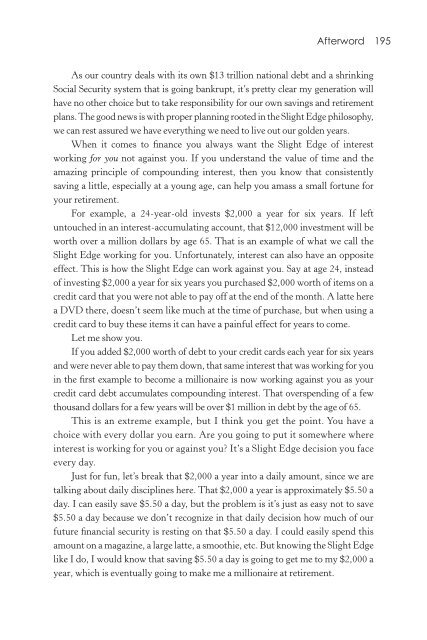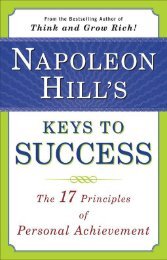The-Slight-Edge
Create successful ePaper yourself
Turn your PDF publications into a flip-book with our unique Google optimized e-Paper software.
Afterword 195<br />
As our country deals with its own $13 trillion national debt and a shrinking<br />
Social Security system that is going bankrupt, it’s pretty clear my generation will<br />
have no other choice but to take responsibility for our own savings and retirement<br />
plans. <strong>The</strong> good news is with proper planning rooted in the <strong>Slight</strong> <strong>Edge</strong> philosophy,<br />
we can rest assured we have everything we need to live out our golden years.<br />
When it comes to finance you always want the <strong>Slight</strong> <strong>Edge</strong> of interest<br />
working for you not against you. If you understand the value of time and the<br />
amazing principle of compounding interest, then you know that consistently<br />
saving a little, especially at a young age, can help you amass a small fortune for<br />
your retirement.<br />
For example, a 24-year-old invests $2,000 a year for six years. If left<br />
untouched in an interest-accumulating account, that $12,000 investment will be<br />
worth over a million dollars by age 65. That is an example of what we call the<br />
<strong>Slight</strong> <strong>Edge</strong> working for you. Unfortunately, interest can also have an opposite<br />
effect. This is how the <strong>Slight</strong> <strong>Edge</strong> can work against you. Say at age 24, instead<br />
of investing $2,000 a year for six years you purchased $2,000 worth of items on a<br />
credit card that you were not able to pay off at the end of the month. A latte here<br />
a DVD there, doesn’t seem like much at the time of purchase, but when using a<br />
credit card to buy these items it can have a painful effect for years to come.<br />
Let me show you.<br />
If you added $2,000 worth of debt to your credit cards each year for six years<br />
and were never able to pay them down, that same interest that was working for you<br />
in the first example to become a millionaire is now working against you as your<br />
credit card debt accumulates compounding interest. That overspending of a few<br />
thousand dollars for a few years will be over $1 million in debt by the age of 65.<br />
This is an extreme example, but I think you get the point. You have a<br />
choice with every dollar you earn. Are you going to put it somewhere where<br />
interest is working for you or against you? It’s a <strong>Slight</strong> <strong>Edge</strong> decision you face<br />
every day.<br />
Just for fun, let’s break that $2,000 a year into a daily amount, since we are<br />
talking about daily disciplines here. That $2,000 a year is approximately $5.50 a<br />
day. I can easily save $5.50 a day, but the problem is it’s just as easy not to save<br />
$5.50 a day because we don’t recognize in that daily decision how much of our<br />
future financial security is resting on that $5.50 a day. I could easily spend this<br />
amount on a magazine, a large latte, a smoothie, etc. But knowing the <strong>Slight</strong> <strong>Edge</strong><br />
like I do, I would know that saving $5.50 a day is going to get me to my $2,000 a<br />
year, which is eventually going to make me a millionaire at retirement.













